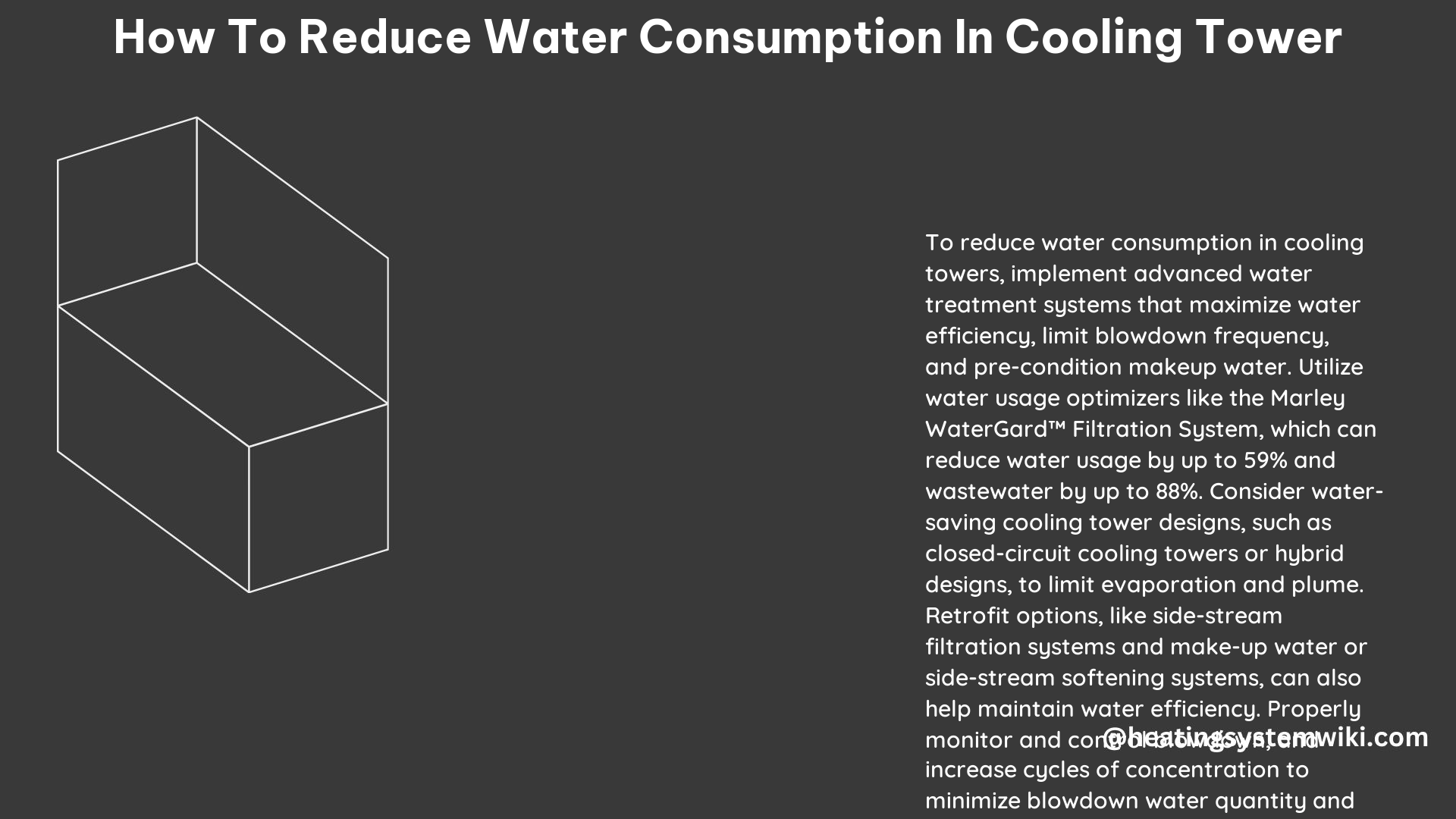Cooling towers are essential components in various industrial and commercial applications, but they can be significant consumers of water. Reducing water consumption in cooling towers is crucial for conserving this precious resource and improving the overall sustainability of these systems. In this comprehensive guide, we will explore various strategies and techniques to help you minimize water usage in your cooling tower operations.
Limit Evaporation
Evaporation is the primary mechanism by which water is lost from a cooling tower system. To limit evaporation, consider the following options:
-
Closed-Circuit Cooling Towers: Also known as fluid coolers, these towers are designed to cool a water/glycol solution in a closed coil, minimizing direct water exposure and reducing evaporative losses. Closed-circuit cooling towers can achieve up to 80% water savings compared to traditional open-circuit towers.
-
Hybrid Cooling Towers: Hybrid designs, such as the Marley NCWD Cooling Tower, combine a wet cooling tower section with a dry, air-cooled section. This allows the system to operate in either evaporative-only or combined wet/dry mode, enabling water conservation while maintaining cooling capacity.
-
Plume Abatement Systems: Technologies like the Marley ClearSky® System use a series of PVC heat exchanger modules in the tower plenum to condense water vapor before it exits the tower. This can reduce water usage by up to 20% or more.
-
Cooling Tower Covers: Installing covers on open distribution decks at the top of the tower can help reduce water loss due to evaporation and biological growth, such as algae.
Reduce Blowdown

Blowdown is the process of removing a portion of the highly concentrated water from the cooling tower and replacing it with fresh make-up water. Careful monitoring and control of blowdown can significantly conserve water.
-
Water Management Program: Implement a comprehensive water management program that includes regular maintenance, water quality testing, and the application of appropriate chemical treatments. This will help maintain optimal water chemistry and minimize the need for blowdown.
-
Water Treatment Professionals: Consult with knowledgeable water treatment experts who can recommend and implement the right chemical treatments, filtration systems, and other technologies to improve water quality and reduce blowdown requirements.
-
Water Usage Optimizers: Install systems like the Marley WaterGard™ Filtration System, which can reduce water usage by up to 59% and wastewater by up to 88% under certain conditions.
Minimize Drift
Drift is the small quantity of water that may be carried from the tower as mist or small droplets. While drift loss is relatively small compared to evaporation and blowdown, it can still be minimized.
-
Drift Eliminators: Ensure that your cooling tower is equipped with high-efficiency drift eliminators, which can capture up to 99.9% of water droplets before they are expelled from the tower.
-
Baffles and Air Inlet Screens: Properly designed baffles and air inlet screens can help reduce the amount of water that is entrained in the air stream and carried out of the tower.
Retrofit Options
Retrofitting your existing cooling tower with various upgrades can also help reduce water consumption:
-
Side-Stream Filtration: Installing a side-stream filtration system can remove silt, suspended solids, and other contaminants from the recirculating water, reducing the need for blowdown.
-
Water Softening: If hardness (calcium and magnesium) is the limiting factor on cycles of concentration, installing a make-up water or side-stream softening system can allow for higher cycles of concentration and lower blowdown requirements.
-
Alternative Water Treatment: Exploring alternative water treatment options, such as ozonation or ionization, can help minimize the use of chemical additives and reduce water consumption.
Replacement Options
In some cases, replacing an older, less efficient cooling tower with a newer, more water-efficient model may be the best solution.
-
Consult Experts: Work with cooling tower experts to evaluate the feasibility and potential benefits of replacing your existing tower. They can help you assess the water and energy savings that can be achieved with a newer design.
-
Improved Materials and Design: Advancements in cooling tower materials and design can significantly reduce water and energy requirements. Newer towers may incorporate features like high-efficiency fill, low-drift eliminators, and advanced water management systems.
Maximize Cycles of Concentration
Increasing the cycles of concentration, or the ratio of the concentration of dissolved solids in the blowdown water compared to the make-up water, can minimize blowdown water quantity and reduce make-up water demand.
-
Water Chemistry Optimization: Work with water treatment professionals to optimize the water chemistry in your cooling tower, ensuring that the cycles of concentration are maximized without exceeding the limits of your make-up water quality and system materials.
-
Monitoring and Adjustments: Regularly monitor the water quality and make necessary adjustments to maintain the optimal cycles of concentration, balancing water conservation with system performance and longevity.
By implementing these strategies, you can significantly reduce water consumption in your cooling tower operations, contributing to overall sustainability and environmental stewardship. Remember to consult with experts, regularly maintain your system, and continuously monitor and optimize your water management practices for the best results.
Reference:
– How to Conserve Water in Evaporative Cooling Towers
– Best Management Practice #10: Cooling Tower Management
– How to Conserve Water by Improving Cooling Tower Efficiency
